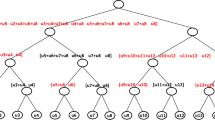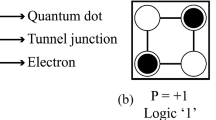Abstract
In this paper, a power- and area-efficient, multirate, Quasi-cyclic, low-density, parity-check decoder is proposed. The proposed decoder design is based on a simplified adaptive normalized min-sum algorithm. The proposed algorithm effectively utilizes two correction factors for check-node and variable-node update processes. This corrects the channel errors at relatively low signal-to-noise ratio. In order to reduce the finite word length effects, a six-bit nonuniform quantization with the overlapped message passing scheme is used. In addition, an improved early termination scheme is also used to reduce the total number of decoding iterations. This reduces the overall power consumption of the decoder. The simulations have been carried out using Xilinx ISE 14.1 and implemented on Virtex 5 FPGA. The proposed decoder is synthesized using CADENCE with UMC 130 nm technology. With a core area of 1.16 mm\(^{2}\), the proposed decoder achieves a maximum throughput of 3.4 Gb/s for 15 decoding iterations with a power dissipation of 114.3 mW.









Similar content being viewed by others
References
V.A. Chandrasetty, S.M. Aziz, FPGA implementation of a LDPC decoder using a reduced complexity message passing algorithm. J. Netw. 6(1), 36–45 (2011)
M.A. Chao et al., Matrix merging scheme and efficient decoding techniques for reconfigurable QC-LDPC decoders. J. Signal Process. Syst. 68(2), 183–202 (2012)
Y.H. Chen, et al., A Channel-Adaptive Early Termination strategy for LDPC decoders, in Proceedings of IEEE Workshop on Signal Processing Systems, Oct 2009, pp. 226–231
J. Chen, M.P.C. Fossorier, Near-optimum universal belief-propagation-based decoding of low-density-parity check codes. IEEE Trans. Commun. 50(3), 406–414 (2002)
J. Chen et al., Construction of irregular LDPC codes by quasi-cyclic extension. IEEE Trans. Inf. Theory 53(4), 1479–1483 (2007)
K. Cushon et al., A min-sum iterative decoder based on pulsewidth message encoding. IEEE Trans. Circuits Syst. II 57(11), 893–897 (2010)
Y. Dai et al., Optimal overlapped message passing decoding of quasi-cyclic LDPC codes. IEEE Trans. VLSI Syst. 16(5), 565–578 (2008)
M.P.C. Fossorier et al., Reduced complexity iterative decoding of low density parity check codes based on belief propagation. IEEE Trans. Commun. 47(5), 673–680 (1999)
R.G. Gallager, Low-density parity-check codes. IRE Trans. Inf. Theory IT–8, 21–28 (1962)
K. Gunnam, et al., Multi-rate Layered Decoder Architecture for Block LDPC Codes of IEEE 802.11n Wireless Standard, in Proceedings of IEEE International Symposium on Circuits and Systems (ISCAS), May 2007, pp. 1645–1648
D.E. Hocevar, A Reduced Complexity Decoder Architecture via Layered Decoding of LDPC Codes, in Proceedings of IEEE Workshop on Signal Processing Systems, Austin, TX, Oct 2004, pp. 107–112
IEEE, IEEE Standard 802.11n-2009, Part 11: Wireless LAN Medium Access Control (MAC) and Physical Layer (PHY) Specifications—Amendment 5: Enhancement for Higher Throughput, (IEEE, 2009)
IEEE, IEEE Standard for Local and Metropolitan Area Networks Part 16: Air Interface for Broadband Wireless Access Systems, IEEE Std 802.16-2009 (Revision of IEEE Std 802.16-2004), (IEEE, 2009).
N.S. Jayant, Waveform Quantization and Coding (IEEE Press Selected Reprint Series) (John Wiley & Sons Canada limited, Mississauga, 1976)
J. Jin, C. Tsu, Improving the Hardware Utilization Efficiency of Partially Parallel LDPC Decoder with Scheduling and Sub-matrix Decomposition, in Proceedings of IEEE International Symposium on Circuits and Systems, May 2009, pp. 2233–2236
M. Karkooti et al., Configurable, high throughput, irregular LDPC decoder architecture: tradeoff analysis and implementation, in Proceedings of IEEE international conference on Application Specific Systems, Architectures and Processors, Sept 2006, pp. 360–367
L. Liu, C.J.R. Shi, Sliced message passing: high throughput overlapped decoding of high-rate low-density parity-check codes. IEEE Trans. Circuits Syst.-I 55(11), 3697–3710 (2008)
M.G. Luby et al., Improved low-density parity-check codes using irregular graphs. IEEE Trans. Inf. Theory 47(2), 585–598 (2001)
T. Mohsenin et al., A low-complexity message-passing algorithm for reduced routing congestion in LDPC decoders. IEEE Trans. Circuits Syst. I 57(5), 1048–1061 (2010)
D. Oh, K.K. Parhi, Min-sum decoder architectures with reduced word length for LDPC codes. IEEE Trans. Circuits Syst.-I 57(1), 105–115 (2010)
N. Onizawa et al., Design of high-throughput fully parallel LDPC decoders based on wire partitioning. IEEE Trans. VLSI Syst. 18(3), 482–489 (2010)
T.J. Richardson et al., Design of capacity-approaching irregular low-density parity check codes. IEEE Trans. Inf. Theory 47(2), 619–637 (2001)
T.J. Richardson, R.L. Urbanke, The capacity of low-density parity check codes under message passing decoding. IEEE Trans. Inf. Theory 47(2), 599–618 (2001)
C. Roth, et al., A 15.8 pJ/bit/iter quasi-cyclic LDPC decoder for IEEE 802.11n in 90 nm CMOS, in Proceedings IEEE Asian Solid State Circuits Conference, Nov 2010, pp. 1–4
X.Y. Shih, et al., A 7.39 mm\(^{2}\) 76 mW (1944, 972) LDPC decoder chip for IEEE 802.11n applications, in Proceedings of IEEE Asian Solid-State Circuits Conference (A-SSCC), 2008, pp. 301–304
Y. Sun, et al., Multi-layer Parallel Decoding Algorithm and VLSI Architecture for Quasi-cyclic LDPC Codes, in Proceedings of IEEE International Symposium on Circuits and Systems, May 2011, pp. 1776–1779
X. Wu et al., Adaptive-normalized/offset min-sum algorithm. IEEE Commun. Lett. 14(7), 667–669 (2010)
B. Xiang et al., An area-efficient and low-power multirate decoder for quasi-cyclic low-density parity-check codes. IEEE Trans. VLSI Syst. 18(10), 1447–1460 (2010)
J. Zhang, M.P.C. Fossorier, A modified weighted bit-flipping decoding of low-density parity-check codes. IEEE Commun. Lett. 8(3), 165–167 (2004)
J. Zhang et al., Two-dimensional correction for min-sum decoding of irregular LDPC codes. IEEE Trans. Commun. Lett. 10(3), 180–182 (2006)
C. Zhang et al., Flexible LDPC decoder design for multigigabit-per-second applications. IEEE Trans. Circuits Syst.-I 57(1), 116–124 (2010)
Author information
Authors and Affiliations
Corresponding author
Rights and permissions
About this article
Cite this article
Roberts, M.K., Jayabalan, R. A Power- and Area-Efficient Multirate Quasi-Cyclic LDPC Decoder. Circuits Syst Signal Process 34, 2015–2035 (2015). https://doi.org/10.1007/s00034-014-9949-4
Received:
Revised:
Accepted:
Published:
Issue Date:
DOI: https://doi.org/10.1007/s00034-014-9949-4




